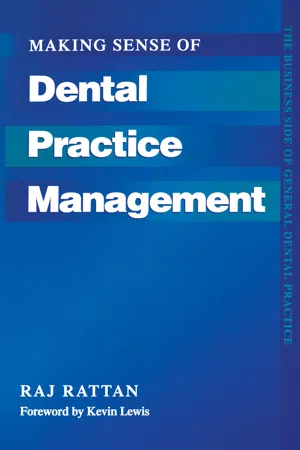
- 200 pages
- English
- ePUB (mobile friendly)
- Available on iOS & Android
Making Sense of Dental Practice Management
About this book
Managing a dental practice has become increasingly complex in recent years, after changes within both the National Health Service and the private sector. Modern dental practice requires that dentists meet demanding business and management challenges as well as employing their clinical expertise. However, most dentists receive little or no formal training in practice management. In this book established management principles are applied specifically to dentistry. It shows how to best serve the interests of patients by effective management of staff, finances, premises and resources. It assumes no prior knowledge, is concise and offers clear, practical advice. It is the definitive guide for dentists, vocational trainees, dental students, practice managers and administrators, and a useful reference for those undertaking the DGDP and MGDS examinations.
Frequently asked questions
- Essential is ideal for learners and professionals who enjoy exploring a wide range of subjects. Access the Essential Library with 800,000+ trusted titles and best-sellers across business, personal growth, and the humanities. Includes unlimited reading time and Standard Read Aloud voice.
- Complete: Perfect for advanced learners and researchers needing full, unrestricted access. Unlock 1.4M+ books across hundreds of subjects, including academic and specialized titles. The Complete Plan also includes advanced features like Premium Read Aloud and Research Assistant.
Please note we cannot support devices running on iOS 13 and Android 7 or earlier. Learn more about using the app.
Information
PART 1
Introduction
1
An introduction to practice management
- ■ changes in NHS dentistry
- ■ developing the private sector
- ■ managing social and regulatory changes
- ■ professional development
- ■ financial performance
- ■ promoting quality in practice
- ■ health and safety legislation.
Efficiency and effectiveness
- ■ optimum use of time
- ■ reduction in wastage of resources
- ■ a balance between time spent and results achieved.
- ■ improved performance
- ■ increased profitability
- ■ attainment of goals
- ■ proper use of resources.
Management theories
FW Taylor (1856-1917)
- ■ work simplification routines may mean that new skills and techniques are not developed
- ■ the emphasis on speed of output is inappropriate for a professional person. Efficiency in work methods is more appropriate
- ■ the work atmosphere can be dehumanized, focusing on levels of activity other than total patient care
- ■ clinicians and administrative staff do not discuss aspects of management together and this can alienate members of the dental team.
Henri Fayol (1841-1925)
- ■ technical
- ■ commercial
- ■ financial
- ■ security
- ■ managerial.
Mary Parker Follett (1868-1933)
Tom J Peters (b. 1942) and Robert H Waterman (b. 1936)
- ■ simplicity of corporate structure
- ■ overriding concern for customer care
- ■ policy to encourage entrepreneurial activity
- ■ hands-on management where senior management is personally involved at all levels
- ■ productivity through people; that is focusing on the team as a resource for quality and productivity.
Table of contents
- Cover Page
- Title Page
- Copyright Page
- Table of Contents
- About the author
- Foreword
- Preface
- Acknowledgements
- PART One Introduction
- PART Two Management Systems
- PART Three Staff Management
- PART Four Practice Development
- PART Five Patient Management
- Index